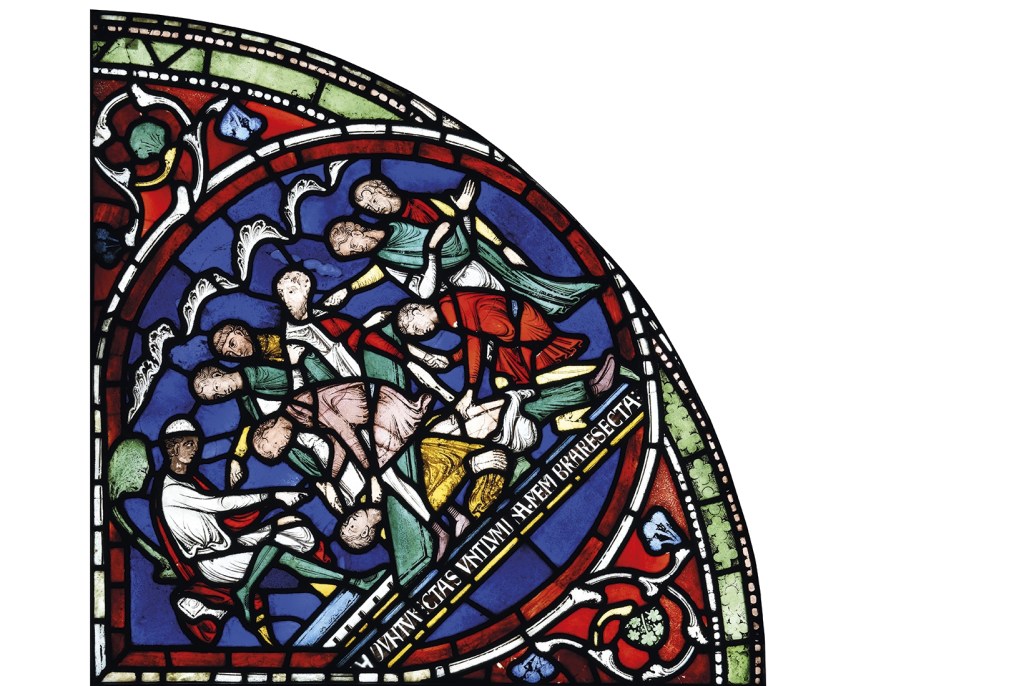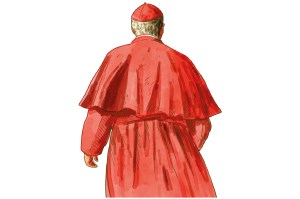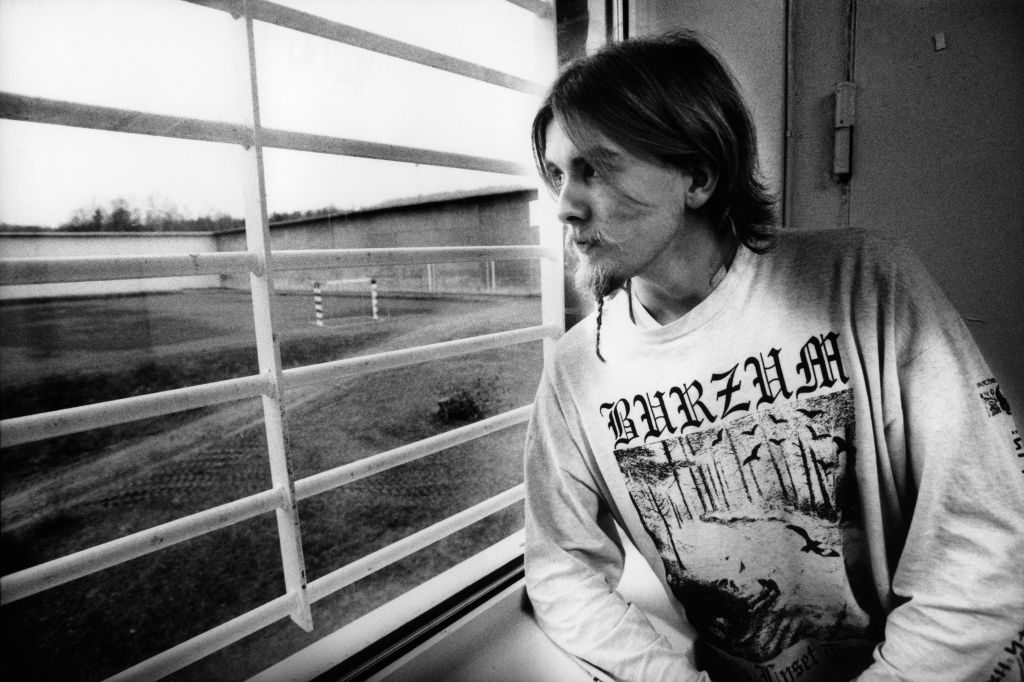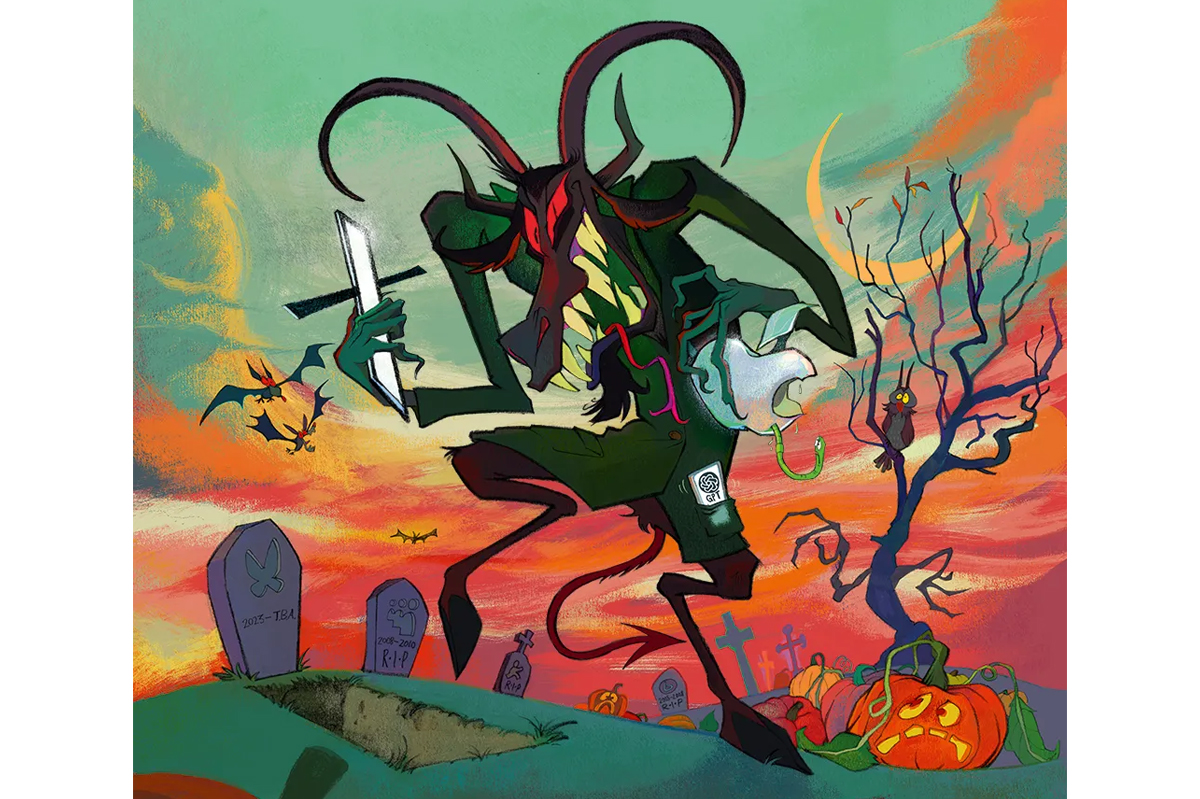Visitors to the British Museum’s new exhibition will become acquainted with one of the most gloriously bizarre stories in the history of English Christianity: the tale of Eilward, a 12th-century Bedfordshire peasant. One day Eilward is in the pub when he has the misfortune to run into his neighbor Fulk, to whom he owes a small debt. An angry confrontation follows; eventually Eilward storms off drunkenly — in the direction of his creditor’s house, where he breaks in and starts trashing the place. Fulk catches him red-handed, beats him up and then hands him over to the authorities. One account suggests Eilward was framed; but whatever the truth of the matter, the judge sentences him to blinding and castration.
Eilward’s punishment, as well as what happened next, is among the scenes portrayed in an exquisite stained-glass window at Canterbury Cathedral, now on loan to the British Museum as the centerpiece of Thomas Becket: Murder and the Making of a Saint. When I spoke to the co-curator, Naomi Speakman, she waxed rhapsodic over the window. ‘This is the first time ever that visitors will be able to see the glass this close up,’ she says. ‘It’s very exciting — and so beautiful as well. It’s not just an interesting historical document: these are masterpieces of medieval art.’
For Speakman, the arrival of the stained glass from Canterbury was an emotional moment. The exhibition was meant to open seven months ago, in time for the 850th anniversary of Becket’s assassination on December 29, 1170. But the anniversary, of course, came and went while the museum doors were shut and the curators were at home, studying PDFs and holding Zoom meetings. Finally the all-clear came and the treasures of the exhibition began to arrive. ‘It was just so wonderful to see the glass coming in and each pane come out of the crate,’ Speakman says. ‘It was a mixture of excitement and, in a way, I guess, disbelief that this was finally happening.’
But back to Eilward, blinded, castrated, and close to death. At this point, he does what many desperate people in the Middle Ages did: he calls for the help of the martyr Thomas Becket. Through Becket’s prayers in heaven — so the story goes — the peasant is completely healed. In the stained-glass window, which depicts this along with some of Becket’s other healing miracles, a green tree emerges symbolically from Eilward’s groin. Canterbury Cathedral was not coy about this episode. In the prayers sung by the cathedral monks for the Feast of St Thomas, they intoned (in Latin):
‘Thomas blazes forth with singular miracles:
‘Male members gives he to the castrated;
‘Sight he bestows on those deprived of eyes.’
For the 16th-century Protestant historian John Foxe, on the other hand, Eilward’s healing was a grotesque myth which just went to show how idiotic the Middle Ages were about the supernatural: ‘This one Miracle (gentle reader) so shameless and impudent, I thought here to express, that by this one thou mightest judge of all the residue of his Miracles…and the filthy wickedness of all these lying Monks.’
Everything about Thomas Becket divides opinion. He has, as the exhibition makes clear, been venerated to an extraordinary degree. In the Middle Ages, Canterbury received up to 100,000 visitors a year, as pilgrims came to pray at the most heavenly site in England: Becket’s shrine, with its golden casket encrusted with sapphires, diamonds, rubies and emeralds, and set on a pink marble floor. A long cultural tradition, from medieval arts and crafts to T.S. Eliot’s Murder in the Cathedral and the 1964 film Becket starring Richard Burton, has added to the legend. Even the Trump administration released an 850th-anniversary tribute. Next year London’s Guildhall Yard will revive the 1519 Becket Pageant, with music, performances, Tudor food and drink, and a craft fair.
But he has also been, for much of the past nine centuries, hated, mocked, smeared, patronized and repeatedly knocked off his perch. Even in the current celebrations you can catch, if you listen closely, a note of unease about this difficult hero.
Becket was an object of suspicion from the moment he became Archbishop of Canterbury in 1162. He had been appointed, not on the basis of any holiness or priestly experience, but because he was King Henry II’s friend and right-hand man. When Becket, on taking the new role, appeared to become a more principled, prayerful figure, his critics smelt hypocrisy. When he started opposing the King, dramatically warning that Henry’s legal reforms were the beginning of tyranny, even Becket’s allies — like the Pope and the King of France — thought he might be going over the top. But after Henry’s knights assassinated Becket, it seemed a vindication: Becket now looked like a martyr, and Henry like a despot who had persecuted the Church. That view spread all over Europe. The exhibition features a carved font from the tiny parish church of Lyngsjö, Sweden, made only 20 years after the murder, which (perhaps a little unfairly) portrays the King urging the knights to do Becket in.
The longstanding fascination with Becket is, from one angle, hard to explain. Much of his dispute with Henry concerned some highly technical details of canon law. But at its heart, there is a drama that anyone can understand. ‘The story of Becket and Henry is almost cinematic in its scope,’ says Speakman. ‘It’s the story of two great friends, who were also the two most powerful people in the country, falling apart.’
Another aspect of Becket’s perennial appeal is that he became an emblem of resistance to authority. Later medieval rebels, for instance, wore Becket badges, some on show at the British Museum. But he has been hated for the same reason. When, in the 16th century, Henry VIII started enforcing his will on the Church, his opponents often harked back to Becket. So Henry issued a royal proclamation: Becket was officially no longer a saint, and images of him were to be destroyed. Tudor priests were repeatedly ordered to scratch two names out of their prayer books: the Pope’s and Becket’s. The Canterbury shrine was obliterated — though parts of it have since been found, including some chunks of marble discovered in the River Stour in 1984 and on display in the exhibition.
Speakman reckons the Reformation-era hostility to Becket ‘has definitely lingered to this day’. In 2006, a BBC History poll to find ‘The worst Briton of the last 1,000 years’ put the archbishop second, behind Jack the Ripper but ahead of Oswald Mosley and Bad King John.
Meanwhile, recent Archbishops of Canterbury have been somewhat reserved about their illustrious predecessor. In a lecture last year, Rowan Williams criticized Henry II for his tyrannical reforms — but hinted that Becket’s ‘individualistic’ approach to the law was not all that much better. Justin Welby’s anniversary sermon, while praising Becket’s courage, cautioned his listeners that ‘Becket’s cause is not our own. We do know better than him in some areas.’
Becket continues, then, to get under people’s skin. That’s part of what has kept him interesting: he’s a hard-edged, recognizably human character, not an icon surrounded by clouds of incense. Even when the knights came to kill him, Becket traded barbs with his assassins, then called one of them ‘you pimp’ and shoved him to the ground. Few people had ever expected Becket to become a great archbishop, never mind a saint. And if you had told his contemporaries that, 850 years on, Becket’s cult would outshine that of any other medieval Englishman, they would have found that quite as incredible as the healing of Eilward the peasant sounds today.
This article was originally published in The Spectator’s UK magazine. Subscribe to the World edition here.

























